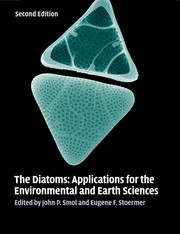Book contents
- Frontmatter
- Contents
- List of contributors
- Preface
- Part I Introduction
- 1 Applications and uses of diatoms: prologue
- 2 The diatoms: a primer
- 3 Numerical methods for the analysis of diatom assemblage data
- Part II Diatoms as indicators of environmental change in flowing waters and lakes
- Part III Diatoms as indicators in Arctic, Antarctic, and alpine lacustrine environments
- Part IV Diatoms as indicators in marine and estuarine environments
- Part V Other applications
- Part VI Conclusions
- Glossary, acronyms, and abbreviations
- Index
- References
3 - Numerical methods for the analysis of diatom assemblage data
from Part I - Introduction
Published online by Cambridge University Press: 05 June 2012
- Frontmatter
- Contents
- List of contributors
- Preface
- Part I Introduction
- 1 Applications and uses of diatoms: prologue
- 2 The diatoms: a primer
- 3 Numerical methods for the analysis of diatom assemblage data
- Part II Diatoms as indicators of environmental change in flowing waters and lakes
- Part III Diatoms as indicators in Arctic, Antarctic, and alpine lacustrine environments
- Part IV Diatoms as indicators in marine and estuarine environments
- Part V Other applications
- Part VI Conclusions
- Glossary, acronyms, and abbreviations
- Index
- References
Summary
Introduction
Research involving diatom assemblages, both modern and fossil, has expanded enormously in recent decades. Because many of the questions asked in such research are quantitative in character (e.g. what was the lake-water pH at AD 1850, what are the major environmental gradients determining the modern diatom assemblages in a set of lakes on the Isle of Skye), there has been a similar development and application of numerical methods appropriate for the quantitative analysis of diatom assemblage data.
Despite diatom ecology and paleoecology being over 100 years old, the relevant statistical methods for assessing the inherent uncertainties associated with diatom counts were only relatively recently developed (in the context of pollen counting) by Mosimann (1965). The application of multivariate data analytical techniques such as cluster analysis, principal components analysis, and correspondence analysis to diatom assemblage data began in the early 1970s. With the upsurge of interest in the mid 1980s in diatom ecology and paleoecology in response to research on the causes of surface-water acidification in Europe and North America, the development and application of data analytical techniques such as canonical correspondence analysis (ter Braak, 1985, 1986) and weighted-averaging regression and calibration (ter Braak & van Dam, 1989) in diatom research expanded greatly (Birks, 1998). Such techniques are now widely used items in the diatomist's tool-kit (Smol et al., 2011 and chapters in this volume).
- Type
- Chapter
- Information
- The DiatomsApplications for the Environmental and Earth Sciences, pp. 23 - 54Publisher: Cambridge University PressPrint publication year: 2010
References
- 48
- Cited by

